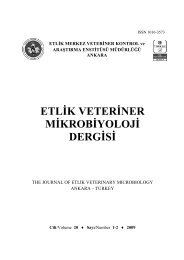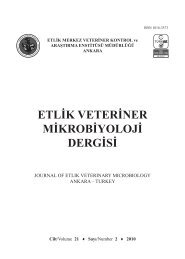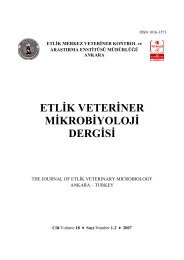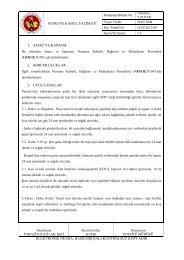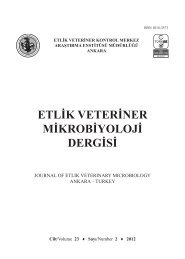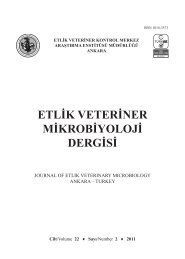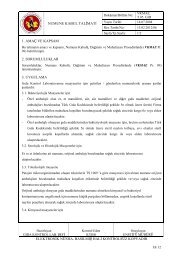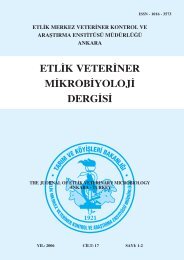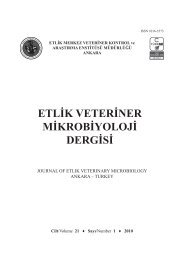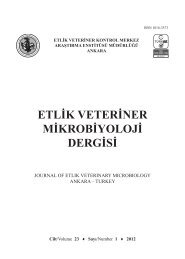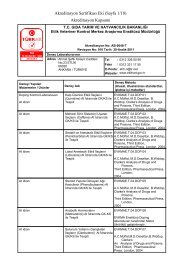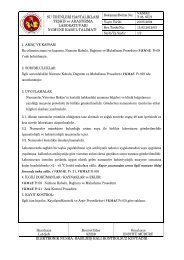Cilt/Volume 19 Sayı/Number 1-2 2008 - veteriner kontrol merkez ...
Cilt/Volume 19 Sayı/Number 1-2 2008 - veteriner kontrol merkez ...
Cilt/Volume 19 Sayı/Number 1-2 2008 - veteriner kontrol merkez ...
You also want an ePaper? Increase the reach of your titles
YUMPU automatically turns print PDFs into web optimized ePapers that Google loves.
28<br />
Hikmet Ün<br />
Turkey December 2005 January 2006 12 4<br />
Iraq January 2006 January 2006 2 2<br />
Azerbaijan February 2006 March 2006 8 5<br />
Egypt March 2006 April 2006 12 4<br />
Total 203 113<br />
Following the initial outbreak, a second<br />
outbreak was confirmed in domestic poultry on 25<br />
December 2005, in the east of the country, Aralık<br />
that is in the district of Igdır Province. Between the<br />
dates of 25 December 2005 and 31 March 2006,<br />
Turkey had 230 confirmed cases of Avian<br />
Influenza, 229 of which were of HPAI (H5N1)<br />
virus and 1 of which was of Low Pathogenic Avian<br />
Influenza (LPAI) H7N1 virus. Amongst these<br />
outbreaks, 200 outbreaks had occurred in domestic<br />
poultry and 30 cases were in wildbirds. Also, some<br />
human avian influenza infection occurred in 2006;<br />
this human case was one of the first confirmed<br />
reports of outside Asia and Africa.<br />
Similar outbreaks occured in neighboring<br />
countries of Turkey and Europe (Table 2)<br />
(www.who.int/csr/disease/avian_influenza/Timeline<br />
_08 12 08.pdf.).<br />
Outbreaks of HPAI H5N1 have been reported<br />
for wildlife and poultry in Turkey and neighbouring<br />
countries since 2005. A phylogenetic analysis of the<br />
hemagglutinin gene showed that the HPAI H5N1<br />
isolates from Turkey were of avian origin and<br />
contained the hemagglutinin gene of the Asian<br />
lineage. The virus isolates in the EU and the<br />
neighbouring countries appear to be genetically<br />
closely related to the Asian lineage of the virus that<br />
has been isolated in China (Qinghai Lake), Russia<br />
(Southern Siberia) and Mongolia.<br />
Table 2. HPAI detection in Europe (Brown, 2006).<br />
Country (estimated 1st report) Wild birds Poultry<br />
Turkey (Oct 2005) + +<br />
Romania (Oct 2005) + +<br />
Croatia (Oct 2005) + -<br />
Ukraine (Dec 2005) ? +<br />
Azerbaijan (Jan 2006) + +<br />
Bulgaria (Jan 2006) + -<br />
Greece (Jan 2006) + -<br />
Italy, Austria, Slovenia, Bosnia- H, Hungary, Poland, Slovakia, Sweden,<br />
Switzerland, Denmark, Albania, Serbia-Montenegro, Slovenia, UK (to April 2006)<br />
+ -/+<br />
France, Germany + +<br />
They are distinguishable from the apparently<br />
chicken-adapted strains infecting domestic poultry<br />
in Turkey. This situation is also supported by wild<br />
bird immigration routes (SABIROVIC et al., 2006).<br />
The reports of the virus finding in dead migratory<br />
waterbirds raised concerns on the potential role of<br />
these birds in the rapid dissemination of the virus<br />
over large geographic distances. Migratory<br />
waterbirds have been thought of a potential for the<br />
introduction of HPAI H5N1 virus to the countries<br />
(Figure 1).



